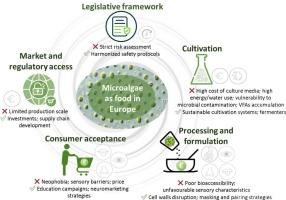欧洲食品工业中的微藻生物量:导航法规、技术创新和消费者接受度
IF 4.5
2区 生物学
Q1 BIOTECHNOLOGY & APPLIED MICROBIOLOGY
Algal Research-Biomass Biofuels and Bioproducts
Pub Date : 2025-09-01
DOI:10.1016/j.algal.2025.104288
引用次数: 0
摘要
对可持续和营养丰富的食物来源的日益增长的需求使微藻成为食品工业的一种有前途的成分。微藻富含优质蛋白质、必需脂肪酸、维生素和生物活性化合物,在健康食品的功能成分开发中具有很大的潜力。然而,监管、技术和消费者相关的障碍仍然限制了它们在西方国家的广泛采用。虽然某些品种有消费历史,但许多品种在商业化前仍需要获得欧盟新食品法规的批准。此外,由于蛋白质相互作用、吸水动力学、生物可及性限制和最终感官属性,加工和配方方面的挑战也会出现,因为它们的强色素沉着和海洋味会影响消费者的接受度。研究证实,在主要产品中,低掺入水平(≤3%)通常保持良好的感官性能。在新兴的应用中,肉类类似物代表了一个特别有前途的领域,其中产品类别的新颖性允许更灵活的口味期望和感官重新解释,尽管纹理化的限制仍然存在。感官优化策略,包括封装和风味掩蔽,正在探索提高适口性,而脉冲电场,机械(即超声波,高压均质)和酶处理正在实施,以提高营养吸收。尽管食品恐惧症、饮食习惯和成本仍然是消费者接受微藻食品的主要障碍,但神经营销方法为影响认知和鼓励采用提供了有希望的工具。在种植效率、基因工程、配方和加工技术方面的进步正在逐步提高微藻的可扩展性、可负担性和感官吸引力,为微藻从利基应用向主流食品替代品发展铺平了道路。本文章由计算机程序翻译,如有差异,请以英文原文为准。

Microalgal biomass in the European food industry: navigating regulation, technological innovation, and consumer acceptance
The growing need for sustainable and nutrient-dense food sources has positioned microalgae as a promising ingredient for the food industry. Rich in high-quality proteins, essential fatty acids, vitamins, and bioactive compounds, microalgae hold great potential as functional ingredients in the development of health-promoting food products. However, regulatory, technological, and consumer-related barriers still limit their widespread adoption in Western countries. While certain species have a history of consumption, many still require approval under the EU Novel Food Regulation before commercialization. Additionally, processing and formulation challenges arise due to protein interactions, water absorption dynamics, bioaccessibility constraints, and final sensory attributes, as their strong pigmentation and marine-like flavours can impact consumer acceptance. Studies confirm that low incorporation levels (≤3 %) generally maintain favourable sensory properties in staple products. Among emerging applications, meat analogues represent a particularly promising area, where the novelty of the product category allows for more flexible taste expectations and sensory reinterpretation, although limitations in texturization remain. Sensory optimization strategies, including encapsulation and flavour masking, are being explored to enhance palatability, while pulsed electric field, mechanical (i.a., ultrasounds, high-pressure homogenization) and enzymatic treatments are being implemented to improve nutrients absorption. Although food neophobia, dietary habits, and cost remain key barriers to consumer acceptance of microalgae-based foods, neuromarketing approaches offer promising tools to influence perception and encourage adoption. Advances in cultivation efficiency, genetic engineering, formulation and processing techniques are progressively improving scalability, affordability, and sensory appeal, paving the way for microalgae to evolve from niche applications to mainstream food alternatives.
求助全文
通过发布文献求助,成功后即可免费获取论文全文。
去求助
来源期刊

Algal Research-Biomass Biofuels and Bioproducts
BIOTECHNOLOGY & APPLIED MICROBIOLOGY-
CiteScore
9.40
自引率
7.80%
发文量
332
期刊介绍:
Algal Research is an international phycology journal covering all areas of emerging technologies in algae biology, biomass production, cultivation, harvesting, extraction, bioproducts, biorefinery, engineering, and econometrics. Algae is defined to include cyanobacteria, microalgae, and protists and symbionts of interest in biotechnology. The journal publishes original research and reviews for the following scope: algal biology, including but not exclusive to: phylogeny, biodiversity, molecular traits, metabolic regulation, and genetic engineering, algal cultivation, e.g. phototrophic systems, heterotrophic systems, and mixotrophic systems, algal harvesting and extraction systems, biotechnology to convert algal biomass and components into biofuels and bioproducts, e.g., nutraceuticals, pharmaceuticals, animal feed, plastics, etc. algal products and their economic assessment
 求助内容:
求助内容: 应助结果提醒方式:
应助结果提醒方式:


